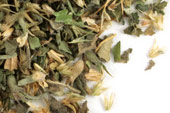Catnip leaf & flower cut & sifted
Catnip leaf & flower cut & sifted
Couldn't load pickup availability
Catnip
Brew a bit of botanical history with our Catnip Leaf & Flower Cut & Sifted. Catnip (Nepeta cataria), a cherished member of the mint family, has traveled through cultures and centuries as a trusted herb for well-being. Indigenous to Europe and Asia, this soothing plant has found its way into teas, tinctures, and traditions worldwide—valued by everyone from ancient Romans to loving mothers seeking to calm colicky babies.
Key Constituents & Herbal Actions
Our catnip is rich in naturally occurring compounds like nepetalactone and volatile oils, which bestow it with a range of therapeutic properties. Anti-inflammatory and nervine, it can ease digestive discomforts like stomachaches and colic, while its mild sedative effect makes it a fantastic choice for restless nights—or to support tranquility during a hectic day. Its benefits are not limited to humans; it’s famously adored by cats while also doubling as a natural pest repellent.
Gentle and Safe for All Ages
Even the littlest members of your family can benefit from this gentle herb. Nursing mothers have found that drinking catnip tea can pass calming benefits to their infants, reducing colic naturally. However, a note of caution—avoid combining it with other sedative medications, and always consult your physician or herbal specialist when in doubt.
Multifaceted Uses
- For Humans: Turn it into a comforting tea for an upset stomach, or add it to your herbal blends for a calming wind-down ritual.
- For Furry Friends: Treat your cats to a little fun and joy by sprinkling catnip leaves in their play area—they'll love the invigorating and hypnotic effects.
- For the Garden: Catnip is an unsung hero outside, repelling mosquitoes and other pests—and even attracting lacewings that keep aphids at bay.
Bring home this versatile and extraordinary herb to weave wellness into every corner of your life. Whether you’re sipping tea by the fire or catering to your favorite feline, Catnip Leaf & Flower will never cease to delight.
Grab your 4oz pouch for $7.30 today – because life tastes better when it comes with comfort.
Share


